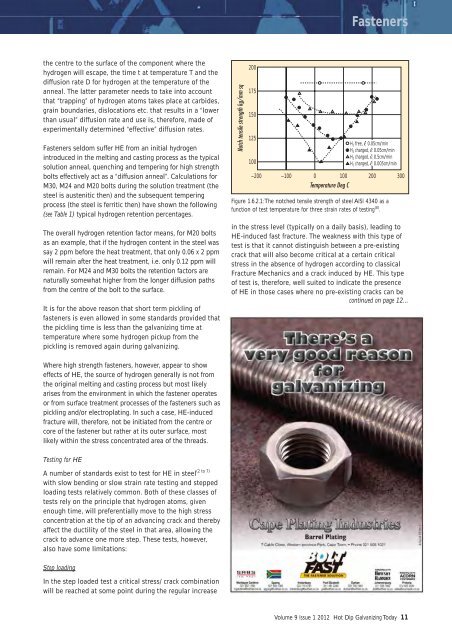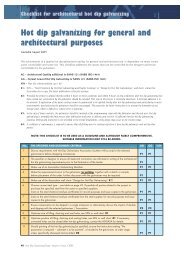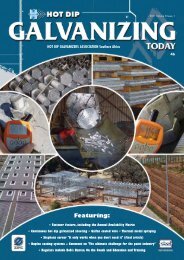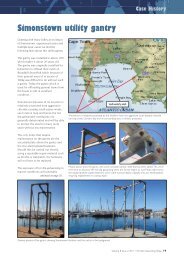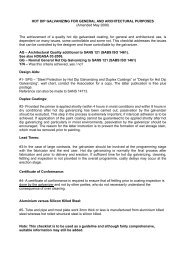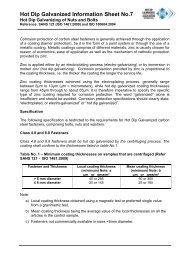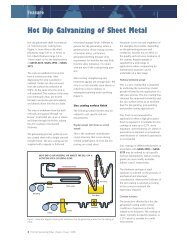Fasteners - hdgasa
Fasteners - hdgasa
Fasteners - hdgasa
You also want an ePaper? Increase the reach of your titles
YUMPU automatically turns print PDFs into web optimized ePapers that Google loves.
<strong>Fasteners</strong><br />
the centre to the surface of the component where the<br />
hydrogen will escape, the time t at temperature T and the<br />
diffusion rate D for hydrogen at the temperature of the<br />
anneal. The latter parameter needs to take into account<br />
that “trapping” of hydrogen atoms takes place at carbides,<br />
grain boundaries, dislocations etc. that results in a “lower<br />
than usual” diffusion rate and use is, therefore, made of<br />
experimentally determined “effective” diffusion rates.<br />
<strong>Fasteners</strong> seldom suffer HE from an initial hydrogen<br />
introduced in the melting and casting process as the typical<br />
solution anneal, quenching and tempering for high strength<br />
bolts effectively act as a “diffusion anneal”. Calculations for<br />
M30, M24 and M20 bolts during the solution treatment (the<br />
steel is austenitic then) and the subsequent tempering<br />
process (the steel is ferritic then) have shown the following<br />
(see Table 1) typical hydrogen retention percentages.<br />
The overall hydrogen retention factor means, for M20 bolts<br />
as an example, that if the hydrogen content in the steel was<br />
say 2 ppm before the heat treatment, that only 0.06 x 2 ppm<br />
will remain after the heat treatment, i.e. only 0.12 ppm will<br />
remain. For M24 and M30 bolts the retention factors are<br />
naturally somewhat higher from the longer diffusion paths<br />
from the centre of the bolt to the surface.<br />
It is for the above reason that short term pickling of<br />
fasteners is even allowed in some standards provided that<br />
the pickling time is less than the galvanizing time at<br />
temperature where some hydrogen pickup from the<br />
pickling is removed again during galvanizing.<br />
Notch tensile strength kg/mm sq<br />
200<br />
175<br />
150<br />
125<br />
100<br />
H 2 free, ε . 0.05cm/min<br />
H 2 charged, ε . 0.05cm/min<br />
H 2 charged, ε . 0.5cm/min<br />
H 2 charged, ε . 0.005cm/min<br />
–200 –100 0 100 200 300<br />
Temperature Deg C<br />
Figure 1.6.2.1:The notched tensile strength of steel AISI 4340 as a<br />
function of test temperature for three strain rates of testing (8) .<br />
in the stress level (typically on a daily basis), leading to<br />
HE-induced fast fracture. The weakness with this type of<br />
test is that it cannot distinguish between a pre-existing<br />
crack that will also become critical at a certain critical<br />
stress in the absence of hydrogen according to classical<br />
Fracture Mechanics and a crack induced by HE. This type<br />
of test is, therefore, well suited to indicate the presence<br />
of HE in those cases where no pre-existing cracks can be<br />
continued on page 12...<br />
Where high strength fasteners, however, appear to show<br />
effects of HE, the source of hydrogen generally is not from<br />
the original melting and casting process but most likely<br />
arises from the environment in which the fastener operates<br />
or from surface treatment processes of the fasteners such as<br />
pickling and/or electroplating. In such a case, HE-induced<br />
fracture will, therefore, not be initiated from the centre or<br />
core of the fastener but rather at its outer surface, most<br />
likely within the stress concentrated area of the threads.<br />
Testing for HE<br />
(2 to 7)<br />
A number of standards exist to test for HE in steel<br />
with slow bending or slow strain rate testing and stepped<br />
loading tests relatively common. Both of these classes of<br />
tests rely on the principle that hydrogen atoms, given<br />
enough time, will preferentially move to the high stress<br />
concentration at the tip of an advancing crack and thereby<br />
affect the ductility of the steel in that area, allowing the<br />
crack to advance one more step. These tests, however,<br />
also have some limitations:<br />
Step loading<br />
In the step loaded test a critical stress/ crack combination<br />
will be reached at some point during the regular increase<br />
Volume 9 Issue 1 2012 Hot Dip Galvanizing Today 11


